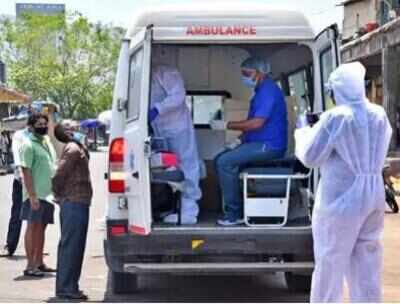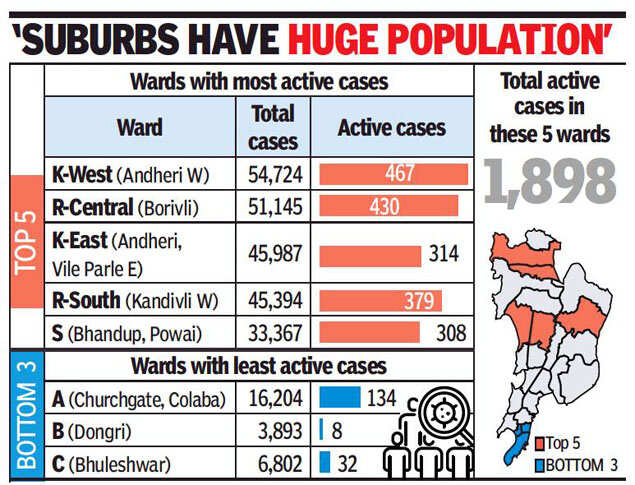Top Searches
- News
- City News
- mumbai News
- Andheri, Borivli & Bhandup still top Covid hotspots, fewer cases in south Mumbai
Andheri, Borivli & Bhandup still top Covid hotspots, fewer cases in south Mumbai

Picture used for representational purpose only
MUMBAI: A ward-wise breakup shows 36% of active Covid-19 cases in the city continue to be restricted to five wards of Mumbai’s suburbs, which include Andheri, Vile Parle East, Borivli, Kandivli and Bhandup. Cases in the five wards total 1,898 compared with 5,267 as on July 27, 2020.
Meanwhile, A, B and C, the three wards in south Mumbai that comprise areas from Colaba to Bhuleshwar, currently have the fewest cases; B Ward (Dongri) has just eight active cases, according to civic data.

K-West and K-East, on the other hand, are the two wards that had the highest concentration of active cases even when the second wave was at its peak in May this year.
Currently, active cases in the K-West Ward, which includes parts of Andheri West, Juhu and Oshiwara, total 467 while K-East, which comprises parts of Andheri, Jogeshwari and Vile Parle East, has 314. Officials said this has a lot to do with the large population of these two wards.
“Both these wards have a huge population ranging between seven and eight lakh, respectively. By comparison, wards such as A, B and C with fewer cases have a population of under two lakh, if one goes by the census data,” said a civic official.
One reason for the high number of cases in K-East is the ward houses airport cargo operations, the Marol police camp as well as Seepz, which have seen fewer restrictions, considering that these fall under the essential category.
According to Census 2011, A Ward has a population of 1.85 lakh while K-East has 8.2 lakh and K-West 7.5 lakh.
Marol resident and activist Godfrey Pimenta said that implementation of restrictions was lax on the ground. “Hawkers and shops operated all through the day without any restrictions in several areas. This defeated the entire purpose of restrictions, of allowing shops to operate only till 4pm, as people kept stepping out thereafter as well for making purchases,” said Pimenta.
Meanwhile, A, B and C, the three wards in south Mumbai that comprise areas from Colaba to Bhuleshwar, currently have the fewest cases; B Ward (Dongri) has just eight active cases, according to civic data.

K-West and K-East, on the other hand, are the two wards that had the highest concentration of active cases even when the second wave was at its peak in May this year.
Currently, active cases in the K-West Ward, which includes parts of Andheri West, Juhu and Oshiwara, total 467 while K-East, which comprises parts of Andheri, Jogeshwari and Vile Parle East, has 314. Officials said this has a lot to do with the large population of these two wards.
“Both these wards have a huge population ranging between seven and eight lakh, respectively. By comparison, wards such as A, B and C with fewer cases have a population of under two lakh, if one goes by the census data,” said a civic official.
One reason for the high number of cases in K-East is the ward houses airport cargo operations, the Marol police camp as well as Seepz, which have seen fewer restrictions, considering that these fall under the essential category.
According to Census 2011, A Ward has a population of 1.85 lakh while K-East has 8.2 lakh and K-West 7.5 lakh.
Marol resident and activist Godfrey Pimenta said that implementation of restrictions was lax on the ground. “Hawkers and shops operated all through the day without any restrictions in several areas. This defeated the entire purpose of restrictions, of allowing shops to operate only till 4pm, as people kept stepping out thereafter as well for making purchases,” said Pimenta.
FacebookTwitterLinkedinEMail
Start a Conversation
end of article

